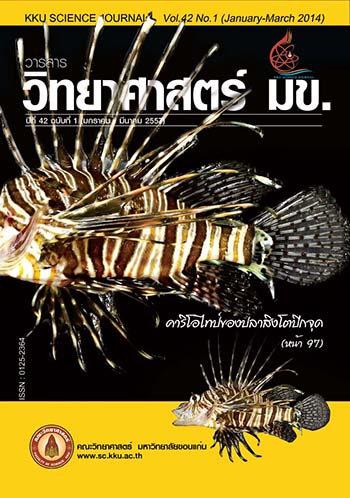Ectoparasite Infestation of Domestic Dogs in Rural Areas of Chiang Rai Province, Northern Thailand
Main Article Content
Abstract
Several ectoparasites on domestic dogs are considered important to public health, particularly fleas, ticks and lice can also transmit pathogens to humans and domestic animals. In this study, a survey of ectoparasite infestation on domestic dogs from eight sub-districts of Mueang Chiang Rai District, Chiang Rai Province, Thailand was performed between June and October 2011. A total of 1,498 ectoparasites belong to three species including Rhipicephalus sanguineus (hard tick: 64.55%), Ctenocephalides felis orientis (flea: 33.85%), and Heterodoxus spiniger (chewing lice: 1.60%). Prevalence of ectoparasite infestation on domestic dogs was 91.25% with the highest prevalence found in Mae Khao Tom and Huai Sak areas (100%) and the lowest in Wiang area (80%). The number of dogs infested were 81.25% (n = 130/146) for Rhipicephalus sanguineus, 53.13% (n = 85/146) for Ctenocephalides felis orientis, and 2.50% (n = 4/146) for Heterodoxus spiniger. The Mean density of ectoparasites per host was 10.26% with the majority being Rhipicephalus sanguineus (7.44%) followed by Heterodoxus spiniger (6.00) and Ctenocephalides felis orientis (5.96). The results demonstrated that the mixed infestations of Rhipicephalus sanguineus and Ctenocephalides felis orientis (46.57%, n = 68) were mostly found in domestic dogs. Both species are the major ectoparasites vector of pathogens transmission from domestic dogs to human and other animals in high prevalence areas.
Article Details

This work is licensed under a Creative Commons Attribution-NonCommercial-NoDerivatives 4.0 International License.


